I’ve been testing the OnePlus 8 series for a bit over a month, and I have good news: the phones are very well made, and the cameras are better than expected. Long story short, starting at $699 for the OnePlus 8 and starting at $899 for the OnePlus 8 Pro, both of these phones have a lot going for them. Let’s dig in.
The OnePlus 8 series includes two 5G-ready models, the OnePlus 8 and the OnePlus 8 Pro. The OnePlus 8 Pro is an ultra-premium flagship phone with all of the premium bells and whistles, including a 6.78″ QHD+ display with a 120Hz refresh rate, water, and dust resistance, a 4,510mAh battery, and OnePlus’s Warp Charge 30T that can take the phone from 1 – 50% charge in about 23 minutes (it also offers reverse wireless charging), and it has a 48-megapixel quad-camera system. The OnePlus 8 is a slightly more compact premium smartphone that provides the flagship features users want without making them compromise on pocketability. The OnePlus 8 has a 6.55″ Fluid AMOLED display with a 90Hz refresh rate, a 4300mAh battery with Warp Charge 30T that can take the phone from 1 to 50% in about 22 minutes, and it has a 48-megapixel triple camera system. Both phones have very responsive in-display fingerprint sensors and facial recognition.
Both OnePlus 8 series phones have the Qualcomm Snapdragon 865 with the Snapdragon X55 5G Modem-RF System. This gives them both multi-gigabit 5G connectivity, advanced Wi-Fi 6 performance, and “professional-quality photography at Gigapixel speeds, desktop-level gaming with ultra-realistic graphics, and intuitive AI experiences.” They also run OnePlus OxygenOS based on Android 10; this is my second favorite Android OS Skin behind the Google Pixel Series. It is minimalistic, intuitive, and less intrusive than the overlay on the Samsung Galaxy series phones, for instance.
One Plus 8
If you prefer something a bit smaller in your hand than all the current over-sized flagships phones, the OnePlus 8 may be just what you’ve been waiting for. The OnePlus 8 measures approximately 6.3″ tall by 2.9″ wide by 0.35″ thick, and it weighs 6.4 ounces. Inside the bold red OnePlus 8 box, you’ll find the phone, a Warp Charge 30 power adapter, a Warp Type-C Cable (that supports USB 2.0), a quick start guide, a welcome letter, the safety information & warranty card, a sheet of OnePlus stickers, a pre-installed screen protector, and a SIM tray tool.
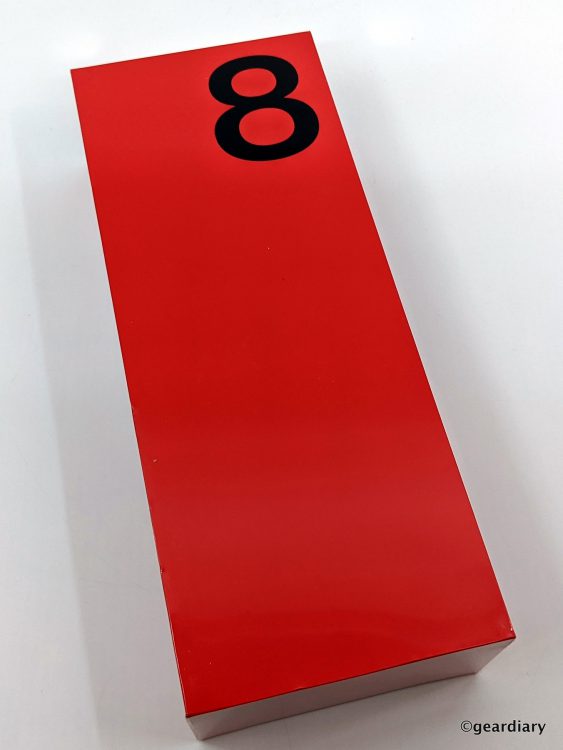


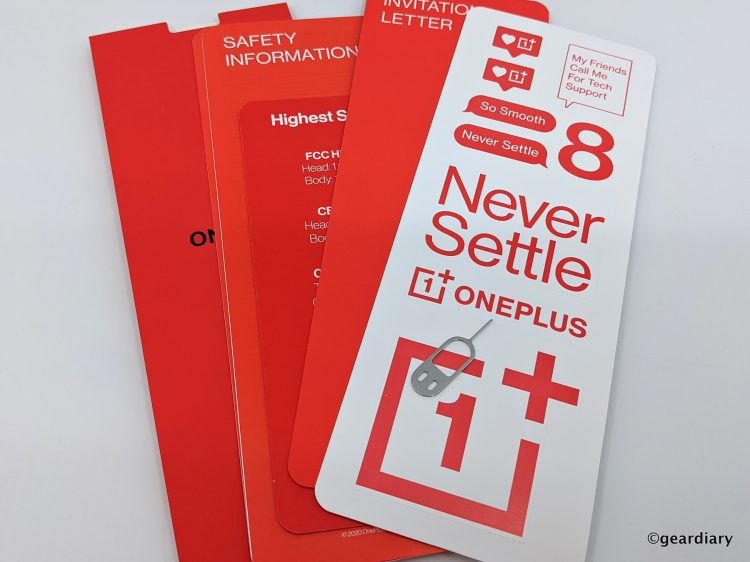
With shorter and tighter curves along the edges of its screen compared to the OnePlus 7 Pro, the OnePlus 8 also has a more comfortable and more secure grip. On the upper left corner of the 3D Corning Gorilla Glass display, the OnePlus 8 has a 3.8mm punch-hole covering the 16-megapixel front-facing camera (with electronic image stabilization). The OnePlus 8’s display has a 20:9 aspect ratio, which is excellent for gaming and watching movies. Before you start thinking that smaller means less powerful, I remind you that the OnePlus 8 has the same Qualcomm Snapdragon 865 and Snapdragon X55 5G Modem-RF system as the 8 Pro. The OnePlus 8 can come with up to 12GB RAM and up to 256GB user memory. The One Plus 8 is available in Onyx Black, matte Glacial Green, and the gorgeous Interstellar Glow I was sent. It’s an absolute fingerprint magnet, but you’ll hardly notice if you wisely keep it in a case.

The curved 3D Corning Gorilla Glass on the front is joined with the 3D Corning Gorilla Glass on the back by a thin aluminum band.
On the right side of the phone, there is a power/wake screen button and OnePlus’s three-stop ring, vibrate, and mute alert slider. The familiar OnePlus slider has ridges cut into it so you can differentiate it from the power button, even when it is in your pocket.
On top of the phone, there is a microphone.
On the left side, there is a volume rocker.

The OnePlus 8’s 3D curved glass has a slight angle on the sides, which may or may not bother you if you are used to a flatter, less curved screen.
On the bottom, there is a dual nanoSIM tray (no memory card slot, sadly), a microphone, the Type-C port, and the speaker cutouts (with the earpiece speaker, it offers dual stereo sound). There is no headphone jack, but in 2020 that hardly seems like something to dock a phone for not including.
Lined up on the back of the OnePlus 8 from top to bottom are a 16-megapixel ultra-wide-angle camera, a 48-megapixel primary camera (with OIS and EIS), a macro camera, and an LED flash just below the slightly raised camera cluster.
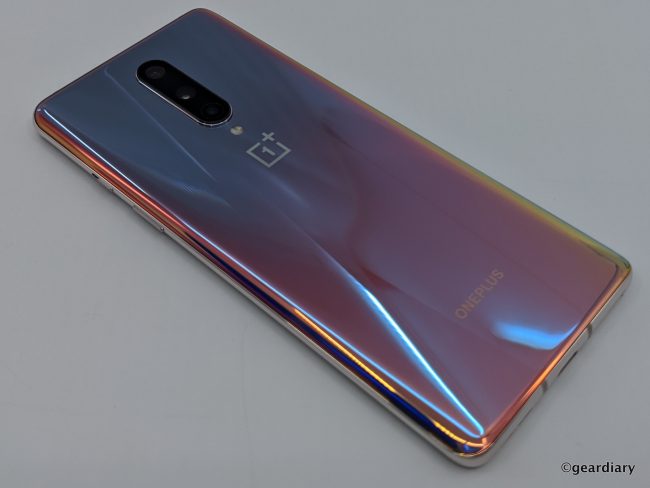
Isn’t the Interstellar Glow color lovely? It’s like a pearlescent white when you see it in real life, but it casts off so many colors that it is hard to pin them down when photographing the phone.
The OnePlus 8 does not offer wireless charging, and the international and unlocked versions do not specify IP dust and water resistance. Still, OnePlus phones generally have some — even when not explicitly rated that way. Worth pointing out, though, is that if you buy your phone from one of the carriers offering it (Verizon and T-Mobile), it will carry the same IP68 rating as the OnePlus 8 Pro.
The OnePlus 8 has a triple-camera system on its rear; the primary camera is 48-megapixel with the Sony IMX586 sensor (with optical image stabilization). The second camera is a 16-megapixel ultra-wide-angle lens with a 116º field of view. The third camera is an independent macro camera. A macro camera may not seem necessary to most, but if you habitually take closeup photos of crazy bugs you come across, or if you are a product reviewer (hi!), or if you are just someone who lists a lot of smaller things on eBay, you’ll appreciate it. Like when using every other phone on a camera, you’ll likely take multiple shots when using it; some will be amazing, and some won’t be quite what you were looking for.
Photos Taken with the OnePlus 8 (click a photo to open the gallery)


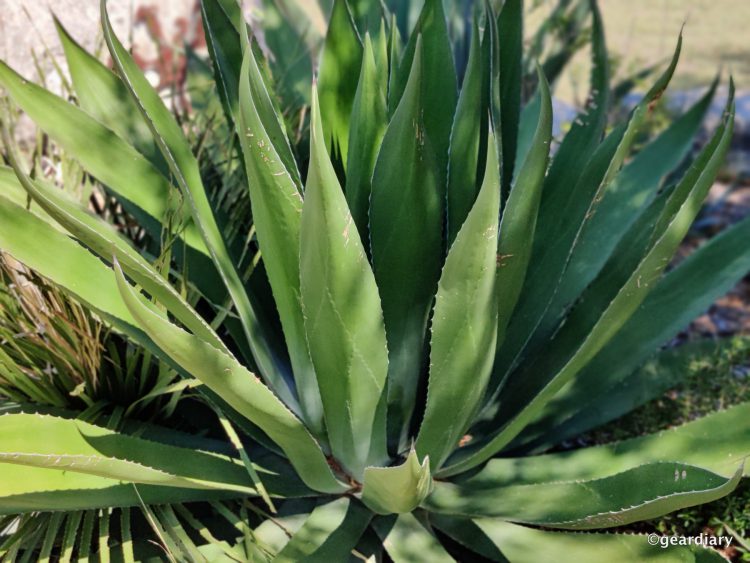








The display on the OnePlus 8 may not have the 120Hz refresh rate of its larger sibling, but unless you are really looking to find something to fault, you won’t even notice. The 6.55″ Full HD+ (2,400 x 1,080 pixel) display is large and brilliant with bright and sharp colors (1100 nits at peak brightness); action on it is smooth and responsive. Thanks to the Qualcomm Snapdragon 865 processor, the OnePlus 8 phone is fast and, again, super responsive; I never noticed a single lag or stutter. Unfortunately, I don’t live in an area with 5G, and thanks to being in lockdown since March, I am not traveling anywhere anytime soon, where I might have been able to test it. Battery life has been better than expected; thanks to years as an Apple and later Pixel user, I’ve been “trained” to expect my phone’s battery to be dead by mid-afternoon with hard use, which is why I still always carry a portable battery pack when I do step out, but the OnePlus 8 has impressed me with its excellent battery life. I can easily get through a full day with it, and if my use is light, I can go without charging until about mid-day on the second day.
Overall, the OnePlus 8 has proven to be an excellent device, and it would be a wise choice for someone who wants something a little bit smaller than the OnePlus 8 Pro without having to accept too many trade-offs for the lower price.
You can see the OnePlus 8’s full list of specifications here.
One Plus 8 Pro
Now comes the beast. As OnePlus’s most feature-rich phone to date, the OnePlus 8 Pro has a 6.78″ (3168×1440) QHD+ Fluid 3D Corning Gorilla Glass Display with a 120Hz refresh rate and 1300 nits at peak brightness. As with the OnePlus 8, a 3.8mm punch-hole on the upper left side of the display houses the front-facing 16-megapixel camera. The hole is so small and over to the side, rather than in the center of the screen, that I don’t even notice it half the time. But even better? The OnePlus 8 Pro is now IP68 rated, so you no longer have to worry about your phone getting wet when you’re soaking in the hot tub after a grueling day of Zoom.
Included in the red OnePlus 8 Pro box are the phone, a Warp Charge 30 power adapter, a Warp Type-C Cable (that supports USB 2.0), a case, a quick start guide, a welcome letter, the safety information and warranty card, a sheet of OnePlus stickers, and a SIM tray tool. The official spec sheet lists a screen protector, but my review unit does not appear to have it pre-installed, and I didn’t find one in the box. :shrug:




TheOnePlus 8 Pro measures approximately 6.5″ tall by 2.9″ wide by 0.35″ thick, and it weighs 7.1 ounces. It is a tall phone, but it is not an overly broad device. With that said, if you are used to a smaller phone, you may find it a bit too big for one-handed use. The OnePlus 8 Pro also has a 3.8mm punch-hole for its 16-megapixel front-facing camera (with EIS) in the upper left corner of its 3D Corning Gorilla Glass display. The OnePlus 8 Pro’s QHD+ and HDR10+ display (3168 x 1440 pixels) has a 19.8:9 aspect ratio, which also performs well when watching movies and playing games. Like the OnePlus 8, the OnePlus 8 Pro can also come up to 12GB RAM and up to 256GB user memory. The One Plus 8 Pro is available in Onyx Black, matte Ultramarine Blue, and the matte Glacial Green that I was sent. The 8 Pro also has 3D curved glass on the front and back with a thin aluminum band in between.
Buttons and ports on the OnePlus 8 Pro are the same as on the OnePlus 8; on the right side, there is a power/display button with a ridged slider above it.
On top, there is a microphone.
There is a volume rocker on the left side.

The OnePlus 8 Pro’s 3D curved glass has a steep angle on the sides, which may or may not bother you if you are used to a flatter, less curved screen.
On the bottom, there is a dual nanoSIM tray (again, no memory card slot), a microphone, a USB Type-C port, and the speaker cutouts (with the earpiece speaker, it also offers dual stereo sound). Again, there is no headphone jack.
The matte back of the OnePlus 8 Pro in Glacial Green is fab because it doesn’t show a lot of fingerprints. To the left of the slightly raised camera array, you’ll find an 8-megapixel hybrid-zoom camera with a 30X digital zoom (with OIS), and a dual-LED flash below it. Inside the camera array, you’ll find a 48-megapixel ultra-wide-angle camera (with a 3cm macro mode), a 48-megapixel primary camera (with OIS and EIS), and a 5-megapixel photochrom color filter camera.

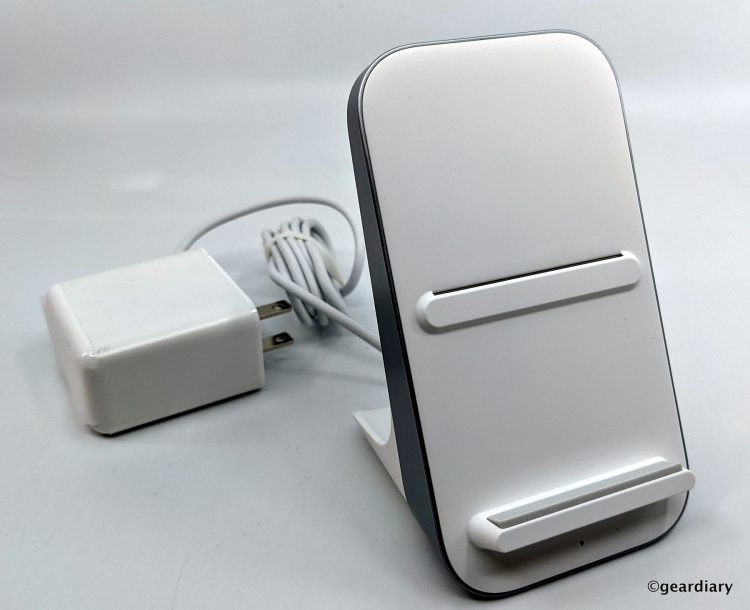



In hand, the OnePlus 8 Pro feels only slightly longer and wider than the OnePlus 8; it is quite sleek and feels like a premium device. Compared to the Samsung Galaxy Ultra that I’ve been using and my usual Pixel 4 XL, it feels especially svelte. I have the 8GB RAM and 128GB user memory version, but I couldn’t really detect a difference from the speed found on the OnePlus 8, which came with 12GB RAM and 256GB user memory. The 120Hz display is brilliant, beautiful, smooth, and super responsive; it ships with 120Hz selected as default, with the option to downgrade to 60Hz; due to its excellent battery life, I have seen no need to lower the speed to get better battery life. Thanks to the Qualcomm Snapdragon 865 processor, the phone is blazing fast, with absolutely no lags or stutters.
The 8 Pro has a 4,510mAh battery that supports Warp 30T charging, taking the phone from 0-50% power in about 23 minutes. Battery life on the OnePlus 8 Pro has been exceptional. I can easily get through a full day of hard use with the screen refresh rate of 120Hz; with lighter use, the phone can easily last well into the next day.
On top of all the other features I’ve mentioned, there is one that sets the OnePlus 8 Pro apart from any model that came before it. It supports Warp Charge 30 Wireless, which — as you guessed it — means wireless charging has finally made its way to OnePlus — along with reverse wireless charging for your small wireless charging capable accessories. Since the phone now has wireless charging, it makes sense that OnePlus also offers its own $69.99 Warp Charge 30 wireless charger; with it, you can charge the 8 Pro from 1 – 50% in about 30 minutes. And because the phone supports wireless charging, it also offers reverse charging, so you can use it to charge other Qi-enabled devices such as your wireless headphones or, in a pinch, another phone. All you have to do is turn it on and place the other device on the 8 Pro’s back.





For many of us, a smartphone’s camera is its most important feature. The OnePlus 8 Pro sports the most significant camera upgrade that the company has ever delivered in its phones. The OnePlus 8 Pro’s primary camera can shoot 4K, and it has hybrid video stabilization (combining Optical Image Stabilization (OIS) and Electronic Image Stabilization(EIS)); there are three hybrid microphones to collect clear stereo audio. Other video recording features include audio zoom —which lets you zoom in on the sounds you want to magnify. There is an audio windscreen on the mics that automatically cuts wind sounds when you are recording. Since good lighting can be such a challenge when shooting video, the 8 Pro has 3-HDR Technology, which weaves together three exposures into one frame with a higher dynamic range; this fills in shadows for more precise, more colorful details.
Photos Taken with the OnePlus 8 Pro (click a photo to open the gallery)
Warning — we had a tarantula in the yard one day, so of course, I took a photo of it.



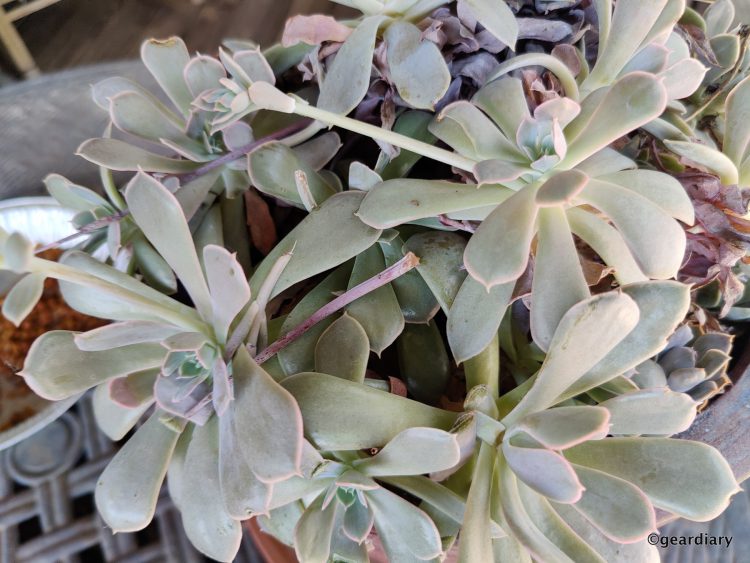









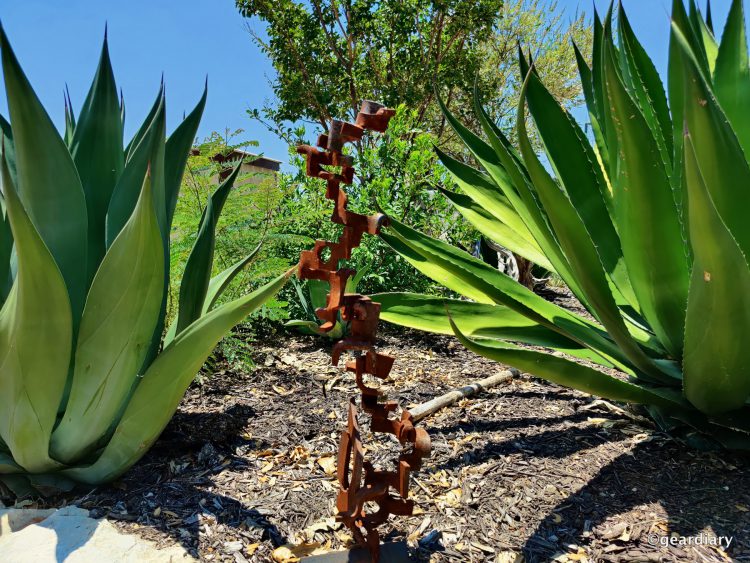

At a starting price of $899, the OnePlus 8 Pro is the company’s most expensive phone yet. The purchase price pain is slightly offset by its gorgeous and large 120Hz display, the Snapdragon 865 processor with X55 modem, its iP68 certification, the excellent cameras, and its 30W wireless charging. The beauty of the OnePlus 8 and the OnePlus 8 Pro being so closely matched to each other is that if you do decide you’d prefer the smaller, less expensive phone, you can still get a fantastic device by giving up just a few of the bells and whistles.
You can see the OnePlus 8 Pro’s full list of specifications here.
The OnePlus 8 starts at $699, and the OnePlus 8 Pro starts at $899; they are available directly from the manufacturer and at T-Mobile, Verizon, and from other retailers, including Amazon.
Source: Manufacturer supplied review sample
What I Like: Both phones have beautiful displays (although the 8 Pro’s 3168 x 1440 pixels are superior to the One Plus 8’s 3168 x 1440 pixels); Both phones are sleek and not overly wide; Excellent cameras; The OnePlus 8 has a 90Hz refresh rate, and the OnePlus 8 Pro has a 120Hz refresh rate; Both phones have highly responsive and accurate in-screen fingerprint readers and facial recognition; Both phones have the top of the line Qualcomm Snapdragon 865, and the Snapdragon Modem X55 5G modem; Both phones have dual nanoSIM slots; Both phones are available in beautiful case colors — not that you’ll ever really see them because these mostly glass phones should be kept in cases; Both phones have excellent battery life
What Needs Improvement: There’s no headphone jack for those who prefer wired headsets; Neither phone can accept a memory card; Both phones have steeply curved sides (the 8 Pro even more so), which may not be to your personal preference









